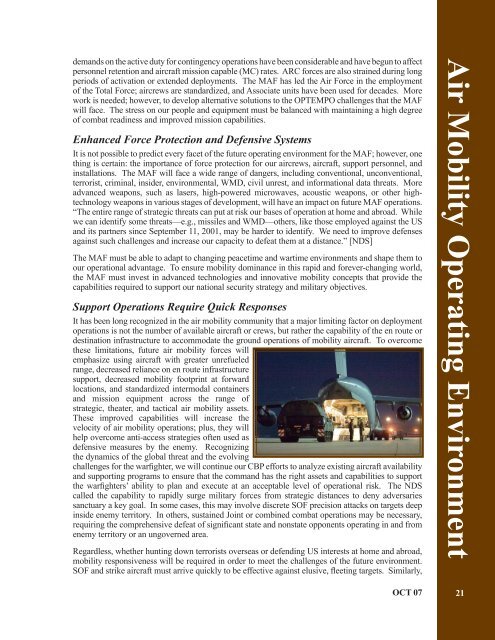Air Mobility Plan, 2008 - The Black Vault
Air Mobility Plan, 2008 - The Black Vault
Air Mobility Plan, 2008 - The Black Vault
Create successful ePaper yourself
Turn your PDF publications into a flip-book with our unique Google optimized e-Paper software.
demands on the active duty for contingency operations have been considerable and have begun to affect<br />
personnel retention and aircraft mission capable (MC) rates. ARC forces are also strained during long<br />
periods of activation or extended deployments. <strong>The</strong> MAF has led the <strong>Air</strong> Force in the employment<br />
of the Total Force; aircrews are standardized, and Associate units have been used for decades. More<br />
work is needed; however, to develop alternative solutions to the OPTEMPO challenges that the MAF<br />
will face. <strong>The</strong> stress on our people and equipment must be balanced with maintaining a high degree<br />
of combat readiness and improved mission capabilities.<br />
Enhanced Force Protection and Defensive Systems<br />
It is not possible to predict every facet of the future operating environment for the MAF; however, one<br />
thing is certain: the importance of force protection for our aircrews, aircraft, support personnel, and<br />
installations. <strong>The</strong> MAF will face a wide range of dangers, including conventional, unconventional,<br />
terrorist, criminal, insider, environmental, WMD, civil unrest, and informational data threats. More<br />
advanced weapons, such as lasers, high-powered microwaves, acoustic weapons, or other hightechnology<br />
weapons in various stages of development, will have an impact on future MAF operations.<br />
“<strong>The</strong> entire range of strategic threats can put at risk our bases of operation at home and abroad. While<br />
we can identify some threats—e.g., missiles and WMD—others, like those employed against the US<br />
and its partners since September 11, 2001, may be harder to identify. We need to improve defenses<br />
against such challenges and increase our capacity to defeat them at a distance.” [NDS]<br />
<strong>The</strong> MAF must be able to adapt to changing peacetime and wartime environments and shape them to<br />
our operational advantage. To ensure mobility dominance in this rapid and forever-changing world,<br />
the MAF must invest in advanced technologies and innovative mobility concepts that provide the<br />
capabilities required to support our national security strategy and military objectives.<br />
Support Operations Require Quick Responses<br />
It has been long recognized in the air mobility community that a major limiting factor on deployment<br />
operations is not the number of available aircraft or crews, but rather the capability of the en route or<br />
destination infrastructure to accommodate the ground operations of mobility aircraft. To overcome<br />
these limitations, future air mobility forces will<br />
emphasize using aircraft with greater unrefueled<br />
range, decreased reliance on en route infrastructure<br />
support, decreased mobility footprint at forward<br />
locations, and standardized intermodal containers<br />
and mission equipment across the range of<br />
strategic, theater, and tactical air mobility assets.<br />
<strong>The</strong>se improved capabilities will increase the<br />
velocity of air mobility operations; plus, they will<br />
help overcome anti-access strategies often used as<br />
defensive measures by the enemy. Recognizing<br />
the dynamics of the global threat and the evolving<br />
challenges for the warfighter, we will continue our CBP efforts to analyze existing aircraft availability<br />
and supporting programs to ensure that the command has the right assets and capabilities to support<br />
the warfighters’ ability to plan and execute at an acceptable level of operational risk. <strong>The</strong> NDS<br />
called the capability to rapidly surge military forces from strategic distances to deny adversaries<br />
sanctuary a key goal. In some cases, this may involve discrete SOF precision attacks on targets deep<br />
inside enemy territory. In others, sustained Joint or combined combat operations may be necessary,<br />
requiring the comprehensive defeat of significant state and nonstate opponents operating in and from<br />
enemy territory or an ungoverned area.<br />
Regardless, whether hunting down terrorists overseas or defending US interests at home and abroad,<br />
mobility responsiveness will be required in order to meet the challenges of the future environment.<br />
SOF and strike aircraft must arrive quickly to be effective against elusive, fleeting targets. Similarly,<br />
<strong>Air</strong> <strong>Mobility</strong> Operating Environment<br />
OCT 07<br />
21
















